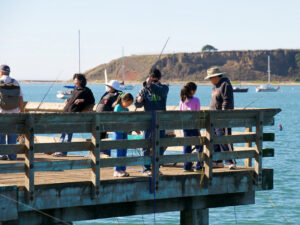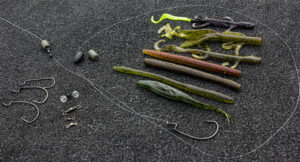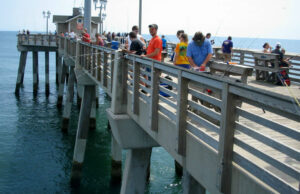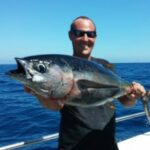Pier Fishing Tips – A Guide to Gear & Fishing Etiquette

It’s a sunny day in southern California. There’s a slight breeze, and it feels good to be outside. The call of the beach and water is strong. You need a plan. Fishing strikes you as one possibility, but you’re just not sure where to go. Maybe you have the kids? Perhaps you only have a few hours? Pier fishing grants easy access, and is a simple activity with just a little preparation. Furthermore, pier fishing in California doesn’t require a fishing license. Grab your rods, reels, and tackle boxes boys and girls! Don’t forget to pack these Pier Fishing Tips, and show off what you know.

Pier Fishing Zones
As you start on down the pier, you are in essence walking into the ocean. You’ll begin fishing in the surf, and head out into deeper water. Up top, you’ll pass by shops, restaurants, pelicans, and a hundred or so people engaged in various activities. Some of them will be fishing. Down below, the scene will change too. Sandsharks, Stingrays, Croaker, Perch, and Corbina abound as you enter the surf. Further out, species of larger sharks, baitfish, Mackerel, and Halibut can be caught. You’ll notice as you go that the gear of your fellow fishermen changes as well.
Pier Fishing Gear
At the base of the pier in the shallow water, the fishermen will have lighter set ups. A 6 -7 foot medium action rod, with a medium sized saltwater spinning reel is perfect for the job here. The best part is this gear doesn’t cost much. You’ll want at least 8 Lb line when fishing this area, but you can go up to 15 Lb if you like. A favorite rig fishermen use here is called the Carolina Rig.
Using the Carolina Rig
 1. Cut a length of line about 4′ long to be used at the end as the leader.
1. Cut a length of line about 4′ long to be used at the end as the leader.
2. Slide a 1 to 1.5 ounce egg weight up the main line.
3. Tie a barrel swivel to the end of the line, which will stop the egg weight from sliding off.
4. Now tie your leader to the other end of the swivel.
5. Tie a small size 2 bait hook on the end of the leader.
That’s it. You made the Carolina Rig! Use sand worms bought at your local tackle store, or scoot on down to the beach and dig up some sand crabs.
This gear will work fine to start. If you want to fish on the outside, you’ll want a heavier set up. A 7-10 foot, medium action rod will work better in deeper water. Put a larger spinning reel (for heavier line) on this one. You can fish the bottom by using a 6-10 ounce torpedo weight. Or fish the top by tying just a 2/0 hook to the end of at least 25 Lb monofilament line. Live bait caught off the pier using a sabiki rig produces fish. Thawed sardine, anchovy, or squid is a good choice too.
One last thing you will need is a way to get that bigger fish all the way up to the top of the pier without breaking your line. A grappling hook will work, but it’ll kill the fish. This could get you in trouble if the fish is too small. Using a Pier Net is a better bet. It won’t hurt the fish.
Gear Recap
✔Use Lighter Gear in the Shallow Surf
- 6-7′ Medium Action Rod
- Medium Saltwater Spin Reel – 8 to 15 lb Test
- 8 – 15 lb Line
- Use Sliding Egg Weights with Swivels and a Leader – Carolina Rig
- A Small #2 Hook
- Use Blood Worms or Sand Crabs for Bait
✔Use Heavier Gear for deeper water
- A 7-10′ Rod
- Use a Larger Spin Reel for Heavier Line
- 6 to 10 Ounce Torpedo Weights
- 2/0 Hooks
- 25 Lb Monofilament Line
- Use Live or Dead Squid, Anchovy, or Sardine for Bait
- Catch Small Bait Fish to Use as Bait
✔Bring a Grappling Hook or Pier Net
Etiquette on the Pier
 The number one rule on the pier is have fun. Bring a chair, sunscreen, food and beverage. Remember to be safe, and respectful of those around you. Clean up before you leave, and call it a great day. Better than working, as they say. If by chance or skill you catch a whopper, the crowds down there are gonna love you! They will want to hear all your pier fishing tips.
The number one rule on the pier is have fun. Bring a chair, sunscreen, food and beverage. Remember to be safe, and respectful of those around you. Clean up before you leave, and call it a great day. Better than working, as they say. If by chance or skill you catch a whopper, the crowds down there are gonna love you! They will want to hear all your pier fishing tips.
As an Amazon Associate, Fishermen's Angle earns from qualifying purchases. We get commissions for purchases made through links in this post.
